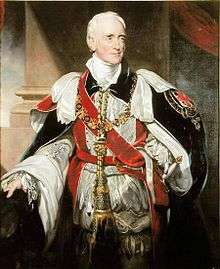Philip Yorke, 3rd Earl of Hardwicke
Philip Yorke, 3rd Earl of Hardwicke, KG, PC, FRS (31 May 1757 – 18 November 1834), known as Philip Yorke until 1790, was a British politician.
The Earl of Hardwicke KG PC FRS | |
|---|---|
 Lord Hardwicke in the robes of the Order of the Garter by Thomas Lawrence | |
| Lord Lieutenant of Ireland | |
| In office 27 April 1801 – 21 November 1805 | |
| Monarch | George III |
| Prime Minister | |
| Preceded by | The Marquess Cornwallis |
| Succeeded by | The Earl of Powis |
| Personal details | |
| Born | 31 May 1757 Cambridge, Cambridgeshire |
| Died | 18 November 1834 (aged 77) |
| Nationality | British |
| Spouse(s) | |
| Alma mater | Queens' College, Cambridge |
Background and education

Born in Cambridge, England, he was the eldest son of Charles Yorke, Lord Chancellor, by his first wife, Catherine Freman. He was educated at Harrow and Queens' College, Cambridge.[1]
In 1790 he succeeded his uncle Philip Yorke, 2nd Earl of Hardwicke to his earldom and estates, including Wimpole Hall.
Political career
Hardwicke was Member of Parliament for Cambridgeshire from 1780 to 1790, following the Whig traditions of his family, but after his succession to the earldom in 1790 he supported William Pitt The Younger, and took office in 1801 as Lord Lieutenant of Ireland (1801–1806), where he supported Catholic emancipation. He was sworn of the Privy Council in 1801, created a Knight of the Garter in 1803, and was a fellow of the Royal Society.
Family
Lord Hardwicke married Lady Elizabeth, daughter of James Lindsay, 5th Earl of Balcarres, in 1782. They had four sons and four daughters. Of the sons:
- Philip Yorke, Viscount Royston (7 May 1784-04 Apr 1808), was Member of Parliament for Reigate but was lost at sea off Lübeck (having died without issue);
- Charles was born 23 Aug 1787 and died Dec. 28, 1791;
- Charles James Yorke, Viscount Royston (14 Jul 1797–30 Apr 1810), died at Wimpole of Scarlet Fever; and
- Joseph John was born 12 Aug 1800 and died in March 1801.
Of the daughters:
- Anne married John Savile, 3rd Earl of Mexborough, and had issue;
- Catherine married Du Pre Alexander, 2nd Earl of Caledon, and had issue;
- Elizabeth married Lord Stuart de Rothesay and had issue;
- Caroline married Earl Somers and had issue.
Lord Hardwicke died on 17 Oct 1834, aged 77, and was buried St Andrew's Church in Wimpole, Cambridgeshire in a tomb by Richard Westmacott (the younger). As he had no surviving male issue, he was succeeded in the earldom by his nephew, Charles. Lady Hardwicke died on 26 May 1858, aged 94.
References
- "Yorke, Philip (YRK774P)". A Cambridge Alumni Database. University of Cambridge.
- Duke of Buckingham: Memoirs of the Court and Cabinets of George III. 4 vols. London, 1853–1855
External links
- Hansard 1803–2005: contributions in Parliament by the Earl of Hardwicke
- . Dictionary of National Biography. London: Smith, Elder & Co. 1885–1900.

| Parliament of Great Britain | ||
|---|---|---|
| Preceded by Sir John Hynde Cotton, Bt Sir Sampson Gideon, Bt |
Member of Parliament for Cambridgeshire 1780–1790 With: Lord Robert Manners 1780–1782 Sir Henry Peyton, Bt 1782–1789 James Whorwood Adeane 1789–1790 |
Succeeded by James Whorwood Adeane Charles Philip Yorke |
| Political offices | ||
| Preceded by The Marquess Cornwallis |
Lord Lieutenant of Ireland 1801–1805 |
Succeeded by The Earl of Powis |
| Honorary titles | ||
| Preceded by The Earl of Hardwicke |
Lord Lieutenant of Cambridgeshire 1790–1834 |
Succeeded by The Earl of Hardwicke |
| Peerage of Great Britain | ||
| Preceded by Philip Yorke |
Earl of Hardwicke 1790–1834 |
Succeeded by Charles Philip Yorke |